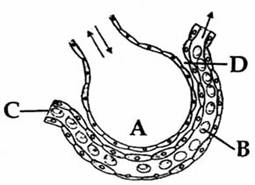NEET Breathing and Respiration Questions (MCQs) | Online MCQs test on Breathing and Exchange of Gases (Class 11) | Online MCQs Test no. 04
Human Respiratory System: MCQs Quiz - 4
Congratulations - you have completed Human Respiratory System: MCQs Quiz - 4.
You scored %%SCORE%% out of %%TOTAL%%.
Your performance has been rated as %%RATING%%
Your answers are highlighted below.
Question 1 |
Opening to the trachea is covered by a small flap of tissues termed as the ______.
Glottis | |
Trachea | |
Epiglottis | |
Larynx |
Question 2 |
The exchange of gases between inhaled air and blood is referred as ______.
Cellular respiration | |
External respiration | |
Internal respiration | |
Circulatory respiration |
Question 3 |
The maximum volume of air contained in the lung by a full forced inhalation is called
Vital capacity | |
Tidal volume | |
Total lung capacity | |
Inspiratory capacity |
Question 4 |
Aerobic respiratory pathway is also termed as ______ pathway.
Anabolic | |
Catabolic | |
Creatine phosphate | |
Amphibolic |
Question 5 |
The maximum volume of air that can be released from the lungs by forceful expiration after deepest inspiration is called the ______.
Total lung capacity | |
Vital capacity | |
Tidal volume | |
Ventilation rate |
Question 6 |
Which one is the cofactor of carbonic anhydrase?
Cu | |
Zn | |
Fe | |
Mg |
Question 7 |
The trachea divides into two smaller tubes called ______.
Bronchi | |
Trachea | |
Microtrachea | |
Eustachian tubes |
Question 8 |
Listed below are four respiratory capacities (a - d) and four jumbled respiratory volumes of a normal human adult
Which one of the following is the correct matching of two capacities and volumes?
Respiratory capacities |
Respiratory volumes |
(a) Residual volume |
2500 mL |
(b) Vital capacity |
3500 mL |
(c) Inspiratory reserve volume |
1200 mL |
(d) Inspiratory capacity |
4500 mL |
(a) 4500 mL, (b) 3500 mL | |
(b) 2500 mL, (c) 4500 mL | |
(c) 1200 mL, (d) 2500 mL | |
(d) 3500 mL, (a) 1200 mL |
Question 9 |
Inner surface of the bronchi, bronchioles and fallopian tubes are lined by
Cubical epithelium | |
Columnar epithelium | |
Squamous epithelium | |
Ciliated epithelium |
Question 10 |
Which one of the following statement is NOT correct regarding trachea?
It usually lies posterior to the muscular esophagus. | |
It splits into the right and left bronchi to supply air to the lungs | |
Opening to the trachea is covered by epiglottis. | |
Tracheal rings are C-shaped |
Question 11 |
Which one of the following statements is incorrect?
Tuberculosis is caused by a rod-shaped bacterium, Mycobacterium tuberculosis. | |
Tuberculosis is highly infectious and can be spread by airborne droplets. | |
Tuberculosis can't be treated by antibiotics | |
In Pulmonary Tuberculosis the elasticity of lungs is reduced. |
Question 12 |
Which one of the followings is NOT correct regarding Exhalation (expiration)?
Expiration is typically a passive process | |
Exhalation starts when the expiratory muscles relax | |
The elastic properties of the lung help to expel deoxygenated air during exhalation | |
During exhalation, elastic properties of the lung help to expel deoxygenated air |
Question 13 |
Which one of the followings is correct regarding larynx?
It prevents foreign objects from entering the trachea | |
It houses the vocal cords | |
It is an organ made of cartilage and connects the pharynx to the trachea | |
All of these are correct. |
Question 14 |
Which one of the following is a possibility for most of us in regard to breathing, by making a conscious effort?
One can consciously breathe in and breathe out by moving the diaphragm alone, without moving the ribs at all | |
The lungs can be made fully empty by forcefully breathing out all air from them | |
One can breathe out air totally without oxygen | |
One can breathe out air through eustachian tubes by closing both the nose and the mouth |
Question 15 |
The figure given below shows a small part of human lung where exchange of gases takes place. In which one of the options given below, the one part A, B, C or D is correctly identified along with its function?


B : Red blood cell - transport of CO2 mainly | |
C : Arterial capillary - passes oxygen to tissues | |
A : alveolar cavity - main site of exchange of respiratory gases | |
D : Capillary wall - exchange of O2 and CO2 takes place here |
Once you are finished, click the button below. Any items you have not completed will be marked incorrect.
There are 15 questions to complete.
Solve online NEET Biology Questions (MCQS) | A huge NEET Biology Question Bank is there with chapter wise NEET Biology questions



can u plz explain Q14 sir
According to this Question It asks what is the possible things if we make a hard effort, so breathe in and breathe out by moving the diaphragm alone, without moving the ribs can be happened.But,Others are not like that……
..ITZ AS A BOON 4 MY NEET PREPARATION..
it is really superb especially to know your understanding and concept
ITS GOOD.
its good method for learning